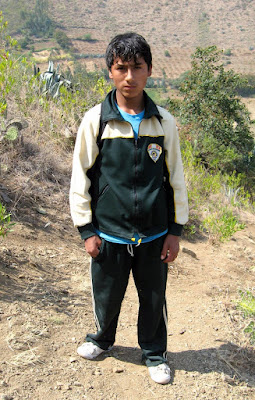 The busy beachfront in Paracas. Unseen to the right is a boardwalk lined with restaurants. I picked a winner with a plate of
The busy beachfront in Paracas. Unseen to the right is a boardwalk lined with restaurants. I picked a winner with a plate of arroz con camparones
-- rice with some kind of saucy shrimp.
So, being an idiot in regards to
la idioma and thus unequipped to dive into danger,
I took my driver´s advice and stayed down the road in Paracas, another small coastal town, attached to a preserve with penguins (allegedly), birds and big fish.
Quite quaint, really, with fishing boats, gruff
pescadores, which I believe is the word for fishermen, pelicans on the shore, birds dive-bombing for food in the bay, and restaurant workers hustling everyone who moves, trying to shoo them into their establishment.
Wound up playing futbol with three ninos, all
once anos, or 11 years old. Alejandre, Jorge and Juan were energetic and as curious about an old white guy in their midst as they were unafraid. After a few attemots to show my affinity for futbol, Alejandre named me Ronaldino (a famous Brazilian soccer player) - which his friends found quite amusing. Alejandre then assigned me to
portero, or goalie. After blocking three of this shots, and none of his two compadres, I explained that I maybe was Ronaldo, and he, in fact, was Ronaldino. His friends roared in assent. Ronaldino, I believe was younger than Ronaldo. And maybe not quite as good.
 The outdoor market amid the ruins that is Pisco. Fresh-plucked chickens and other fresh, raw meats adorn the market.
The outdoor market amid the ruins that is Pisco. Fresh-plucked chickens and other fresh, raw meats adorn the market.This morning, I made my way back to Pisco. To get there, the taxi fare for the 20 km trip is 20 soles -- almost $7. Instead, I asked the first taxi driver to come by,
collectivo? He obliged.
Cuantos? Dos y cinquenta, he said. That's 2 soles and 50 centavos, not quite $1. I got in and we drove about 100 meters, where a dad and his 8ish daughter in school uniform got in. Another 100 meters and a teenage girl got in -- a car smaller than a Camry. About two miles down the road, the last passenger got in and then we hit town. So, if you are prepared to share, as most people in Peru seem to be, you'll pay less. You'll need it.
Only in imagination, and in Pisco, does the word devastation actually convey what grips the little town. More than three quarters of the town's buildings were leveled. Less than half have been rebuilt in the year since. There are no grocery stores -- only outdoor markets that would scare the hell out of any American health inspector. Still, the people are friendly, and patient. I asked people, as best I could, if I could take their picture for
una sole. That´s one unit of Peruvian currency, about 33 cents. Everyone gladly obliged, and most seemed embarassed to take the sole.
 Beans -- and strawberries and peas -- be the family business for these guys.
Beans -- and strawberries and peas -- be the family business for these guys.From Pisco to the Pan-American highway for 20 soles, nearly $7, and the stop for the bus to Ica. This was a most bizarre experience. People show up in drips and drabs, 2, 3 or 5 at a time, and wait for the next bus. One roars in about every 10 minutes and people swarm to the door. There are never as many seats open on the bus as there are people waiting. The first bus I never got near. The second, I ran with the crowd and got shut out. The third, I waited down the road a little and got very near the front -- mostly using by size and weight against the crowd -- and actually got on the bus, but there weren´t enough seats open. The fourth, I again waited, again could push anyone of these smaller folks I wanted, and got on. Four soles for the two-hour drive to Ica -- or about $1.33. Amazing.
 This seemingly relaxed crowd turns into el toro and charges for the bus door when it stops.
This seemingly relaxed crowd turns into el toro and charges for the bus door when it stops.Everybody does it -- it´s how things are done for the vast majority of Peruvians. As this is the main mode of transport for most folks here, because it´s cheap, it´s very busy. Can you believe, though, that the highway, which you almost can´t see, if the main highway the length of the town?
Manana: More about bus and transportation customs, and some about Ica. Holla.




















